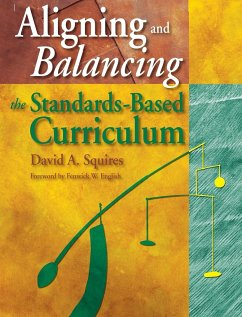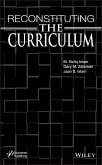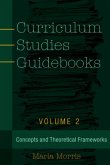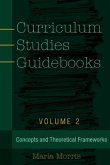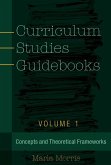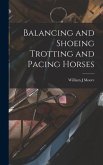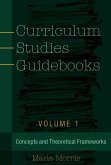David A. Squires
Aligning and Balancing the Standards-Based Curriculum
David A. Squires
Aligning and Balancing the Standards-Based Curriculum
- Gebundenes Buch
- Merkliste
- Auf die Merkliste
- Bewerten Bewerten
- Teilen
- Produkt teilen
- Produkterinnerung
- Produkterinnerung
Full of field-tested implementation tools, this comprehensive handbook shows how schools and districts can use the Balanced Curriculum process to put their schools on the track to success.
Andere Kunden interessierten sich auch für
![Balancing the EDU Life Balancing the EDU Life]() Erin KigerBalancing the EDU Life21,99 €
Erin KigerBalancing the EDU Life21,99 €![Reconstituting the Curriculum Reconstituting the Curriculum]() M. R. IslamReconstituting the Curriculum115,99 €
M. R. IslamReconstituting the Curriculum115,99 €![Curriculum Studies Guidebooks Curriculum Studies Guidebooks]() Marla B. MorrisCurriculum Studies Guidebooks52,30 €
Marla B. MorrisCurriculum Studies Guidebooks52,30 €![Curriculum Studies Guidebooks Curriculum Studies Guidebooks]() Marla B. MorrisCurriculum Studies Guidebooks208,05 €
Marla B. MorrisCurriculum Studies Guidebooks208,05 €![Curriculum Studies Guidebooks Curriculum Studies Guidebooks]() Marla B. MorrisCurriculum Studies Guidebooks52,30 €
Marla B. MorrisCurriculum Studies Guidebooks52,30 €![Balancing and Shoeing Trotting and Pacing Horses Balancing and Shoeing Trotting and Pacing Horses]() William J. MooreBalancing and Shoeing Trotting and Pacing Horses32,99 €
William J. MooreBalancing and Shoeing Trotting and Pacing Horses32,99 €![Curriculum Studies Guidebooks Curriculum Studies Guidebooks]() Marla B. MorrisCurriculum Studies Guidebooks208,05 €
Marla B. MorrisCurriculum Studies Guidebooks208,05 €-
-
-
Full of field-tested implementation tools, this comprehensive handbook shows how schools and districts can use the Balanced Curriculum process to put their schools on the track to success.
Hinweis: Dieser Artikel kann nur an eine deutsche Lieferadresse ausgeliefert werden.
Hinweis: Dieser Artikel kann nur an eine deutsche Lieferadresse ausgeliefert werden.
Produktdetails
- Produktdetails
- Verlag: Corwin
- Seitenzahl: 346
- Erscheinungstermin: 12. Oktober 2004
- Englisch
- Abmessung: 260mm x 208mm x 23mm
- Gewicht: 965g
- ISBN-13: 9780761939627
- ISBN-10: 0761939628
- Artikelnr.: 21002248
- Herstellerkennzeichnung
- Books on Demand GmbH
- In de Tarpen 42
- 22848 Norderstedt
- info@bod.de
- 040 53433511
- Verlag: Corwin
- Seitenzahl: 346
- Erscheinungstermin: 12. Oktober 2004
- Englisch
- Abmessung: 260mm x 208mm x 23mm
- Gewicht: 965g
- ISBN-13: 9780761939627
- ISBN-10: 0761939628
- Artikelnr.: 21002248
- Herstellerkennzeichnung
- Books on Demand GmbH
- In de Tarpen 42
- 22848 Norderstedt
- info@bod.de
- 040 53433511
David A. Squires is currently an associate professor working with doctoral students in the Educational Leadership Program at Southern Connecticut State University, specializing in curriculum, school reform, and organizational development. Previous positions include with the Comer School Development Program at Yale University; as a central office administrator for over a decade in Red Bank, New Jersey, where student achievement improved from below to above grade level; as a research specialist at Research for Better Schools in Philadelphia; as a graduate research assistant in the Learning Research and Development Center at the University of Pittsburgh, where he received his doctorate in curriculum and supervision with minors in language arts education and administration; and as a high school English teacher in suburban Pittsburgh and inner-city Cleveland. He heads a consulting firm, ABC Education Consultants, LLC, that assists school districts in writing and implementing the Balanced Curriculum.
Foreword - Fenwick W. English
Preface
About the Author
About the Balanced Curriculum Web Site
Introduction
Section I. Curriculum Tools and Concepts: Textbooks, Standards, Alignment,
and Standardized Testing
1. Curriculum, Instruction, Assessment, and Standards
2. Textbooks: What the Research Says
3. Understanding and Using National, State, and Local Frameworks and
Standards
4. The Importance of Aligning Curriculum
5. The Conundrum of Standardized Testing
Section II. The Design of the Balanced Curriculum
6. Curriculum Structure and Criteria for a Useful and Useable Curriculum
7. The Balanced Curriculum Process
8. Setting Up the Curriculum Writing Process
9. Defining the Components of a Good Program
10. Reviewing Standards, Sequencing Courses, Describing Units, and
Delineating Unit Timelines
11. Other Standards for Alignment and Balance
12. Generating and Validating Significant Tasks
13. Aligning the Balanced Curriculum With Standards and Assessments
14. Balancing the Aligned Curriculum
15. Constructing Content Assessments
16. Constructing Format Assessments
Section III. Staff Development for and Results of the Balanced Curriculum
17. Introducing the Balanced Curriculum Process in a District
18. Staff Development to Promote Curriculum Implementation
19. The Superintendent¿s Role - Philomena T. Pezzano
20. The Results So Far: Fifteen Years of Data From Urban, Suburban, and
Rural Schools
Bibliography
Index
Preface
About the Author
About the Balanced Curriculum Web Site
Introduction
Section I. Curriculum Tools and Concepts: Textbooks, Standards, Alignment,
and Standardized Testing
1. Curriculum, Instruction, Assessment, and Standards
2. Textbooks: What the Research Says
3. Understanding and Using National, State, and Local Frameworks and
Standards
4. The Importance of Aligning Curriculum
5. The Conundrum of Standardized Testing
Section II. The Design of the Balanced Curriculum
6. Curriculum Structure and Criteria for a Useful and Useable Curriculum
7. The Balanced Curriculum Process
8. Setting Up the Curriculum Writing Process
9. Defining the Components of a Good Program
10. Reviewing Standards, Sequencing Courses, Describing Units, and
Delineating Unit Timelines
11. Other Standards for Alignment and Balance
12. Generating and Validating Significant Tasks
13. Aligning the Balanced Curriculum With Standards and Assessments
14. Balancing the Aligned Curriculum
15. Constructing Content Assessments
16. Constructing Format Assessments
Section III. Staff Development for and Results of the Balanced Curriculum
17. Introducing the Balanced Curriculum Process in a District
18. Staff Development to Promote Curriculum Implementation
19. The Superintendent¿s Role - Philomena T. Pezzano
20. The Results So Far: Fifteen Years of Data From Urban, Suburban, and
Rural Schools
Bibliography
Index
Foreword - Fenwick W. English
Preface
About the Author
About the Balanced Curriculum Web Site
Introduction
Section I. Curriculum Tools and Concepts: Textbooks, Standards, Alignment, and Standardized Testing
1. Curriculum, Instruction, Assessment, and Standards
2. Textbooks: What the Research Says
3. Understanding and Using National, State, and Local Frameworks and Standards
4. The Importance of Aligning Curriculum
5. The Conundrum of Standardized Testing
Section II. The Design of the Balanced Curriculum
6. Curriculum Structure and Criteria for a Useful and Useable Curriculum
7. The Balanced Curriculum Process
8. Setting Up the Curriculum Writing Process
9. Defining the Components of a Good Program
10. Reviewing Standards, Sequencing Courses, Describing Units, and Delineating Unit Timelines
11. Other Standards for Alignment and Balance
12. Generating and Validating Significant Tasks
13. Aligning the Balanced Curriculum With Standards and Assessments
14. Balancing the Aligned Curriculum
15. Constructing Content Assessments
16. Constructing Format Assessments
Section III. Staff Development for and Results of the Balanced Curriculum
17. Introducing the Balanced Curriculum Process in a District
18. Staff Development to Promote Curriculum Implementation
19. The Superintendent's Role - Philomena T. Pezzano
20. The Results So Far: Fifteen Years of Data From Urban, Suburban, and Rural Schools
Bibliography
Index
Preface
About the Author
About the Balanced Curriculum Web Site
Introduction
Section I. Curriculum Tools and Concepts: Textbooks, Standards, Alignment, and Standardized Testing
1. Curriculum, Instruction, Assessment, and Standards
2. Textbooks: What the Research Says
3. Understanding and Using National, State, and Local Frameworks and Standards
4. The Importance of Aligning Curriculum
5. The Conundrum of Standardized Testing
Section II. The Design of the Balanced Curriculum
6. Curriculum Structure and Criteria for a Useful and Useable Curriculum
7. The Balanced Curriculum Process
8. Setting Up the Curriculum Writing Process
9. Defining the Components of a Good Program
10. Reviewing Standards, Sequencing Courses, Describing Units, and Delineating Unit Timelines
11. Other Standards for Alignment and Balance
12. Generating and Validating Significant Tasks
13. Aligning the Balanced Curriculum With Standards and Assessments
14. Balancing the Aligned Curriculum
15. Constructing Content Assessments
16. Constructing Format Assessments
Section III. Staff Development for and Results of the Balanced Curriculum
17. Introducing the Balanced Curriculum Process in a District
18. Staff Development to Promote Curriculum Implementation
19. The Superintendent's Role - Philomena T. Pezzano
20. The Results So Far: Fifteen Years of Data From Urban, Suburban, and Rural Schools
Bibliography
Index
Foreword - Fenwick W. English
Preface
About the Author
About the Balanced Curriculum Web Site
Introduction
Section I. Curriculum Tools and Concepts: Textbooks, Standards, Alignment,
and Standardized Testing
1. Curriculum, Instruction, Assessment, and Standards
2. Textbooks: What the Research Says
3. Understanding and Using National, State, and Local Frameworks and
Standards
4. The Importance of Aligning Curriculum
5. The Conundrum of Standardized Testing
Section II. The Design of the Balanced Curriculum
6. Curriculum Structure and Criteria for a Useful and Useable Curriculum
7. The Balanced Curriculum Process
8. Setting Up the Curriculum Writing Process
9. Defining the Components of a Good Program
10. Reviewing Standards, Sequencing Courses, Describing Units, and
Delineating Unit Timelines
11. Other Standards for Alignment and Balance
12. Generating and Validating Significant Tasks
13. Aligning the Balanced Curriculum With Standards and Assessments
14. Balancing the Aligned Curriculum
15. Constructing Content Assessments
16. Constructing Format Assessments
Section III. Staff Development for and Results of the Balanced Curriculum
17. Introducing the Balanced Curriculum Process in a District
18. Staff Development to Promote Curriculum Implementation
19. The Superintendent¿s Role - Philomena T. Pezzano
20. The Results So Far: Fifteen Years of Data From Urban, Suburban, and
Rural Schools
Bibliography
Index
Preface
About the Author
About the Balanced Curriculum Web Site
Introduction
Section I. Curriculum Tools and Concepts: Textbooks, Standards, Alignment,
and Standardized Testing
1. Curriculum, Instruction, Assessment, and Standards
2. Textbooks: What the Research Says
3. Understanding and Using National, State, and Local Frameworks and
Standards
4. The Importance of Aligning Curriculum
5. The Conundrum of Standardized Testing
Section II. The Design of the Balanced Curriculum
6. Curriculum Structure and Criteria for a Useful and Useable Curriculum
7. The Balanced Curriculum Process
8. Setting Up the Curriculum Writing Process
9. Defining the Components of a Good Program
10. Reviewing Standards, Sequencing Courses, Describing Units, and
Delineating Unit Timelines
11. Other Standards for Alignment and Balance
12. Generating and Validating Significant Tasks
13. Aligning the Balanced Curriculum With Standards and Assessments
14. Balancing the Aligned Curriculum
15. Constructing Content Assessments
16. Constructing Format Assessments
Section III. Staff Development for and Results of the Balanced Curriculum
17. Introducing the Balanced Curriculum Process in a District
18. Staff Development to Promote Curriculum Implementation
19. The Superintendent¿s Role - Philomena T. Pezzano
20. The Results So Far: Fifteen Years of Data From Urban, Suburban, and
Rural Schools
Bibliography
Index
Foreword - Fenwick W. English
Preface
About the Author
About the Balanced Curriculum Web Site
Introduction
Section I. Curriculum Tools and Concepts: Textbooks, Standards, Alignment, and Standardized Testing
1. Curriculum, Instruction, Assessment, and Standards
2. Textbooks: What the Research Says
3. Understanding and Using National, State, and Local Frameworks and Standards
4. The Importance of Aligning Curriculum
5. The Conundrum of Standardized Testing
Section II. The Design of the Balanced Curriculum
6. Curriculum Structure and Criteria for a Useful and Useable Curriculum
7. The Balanced Curriculum Process
8. Setting Up the Curriculum Writing Process
9. Defining the Components of a Good Program
10. Reviewing Standards, Sequencing Courses, Describing Units, and Delineating Unit Timelines
11. Other Standards for Alignment and Balance
12. Generating and Validating Significant Tasks
13. Aligning the Balanced Curriculum With Standards and Assessments
14. Balancing the Aligned Curriculum
15. Constructing Content Assessments
16. Constructing Format Assessments
Section III. Staff Development for and Results of the Balanced Curriculum
17. Introducing the Balanced Curriculum Process in a District
18. Staff Development to Promote Curriculum Implementation
19. The Superintendent's Role - Philomena T. Pezzano
20. The Results So Far: Fifteen Years of Data From Urban, Suburban, and Rural Schools
Bibliography
Index
Preface
About the Author
About the Balanced Curriculum Web Site
Introduction
Section I. Curriculum Tools and Concepts: Textbooks, Standards, Alignment, and Standardized Testing
1. Curriculum, Instruction, Assessment, and Standards
2. Textbooks: What the Research Says
3. Understanding and Using National, State, and Local Frameworks and Standards
4. The Importance of Aligning Curriculum
5. The Conundrum of Standardized Testing
Section II. The Design of the Balanced Curriculum
6. Curriculum Structure and Criteria for a Useful and Useable Curriculum
7. The Balanced Curriculum Process
8. Setting Up the Curriculum Writing Process
9. Defining the Components of a Good Program
10. Reviewing Standards, Sequencing Courses, Describing Units, and Delineating Unit Timelines
11. Other Standards for Alignment and Balance
12. Generating and Validating Significant Tasks
13. Aligning the Balanced Curriculum With Standards and Assessments
14. Balancing the Aligned Curriculum
15. Constructing Content Assessments
16. Constructing Format Assessments
Section III. Staff Development for and Results of the Balanced Curriculum
17. Introducing the Balanced Curriculum Process in a District
18. Staff Development to Promote Curriculum Implementation
19. The Superintendent's Role - Philomena T. Pezzano
20. The Results So Far: Fifteen Years of Data From Urban, Suburban, and Rural Schools
Bibliography
Index

